Shownotes
In this episode, Heather Adkins discusses account-based marketing, sharing the tips that she’s accumulated around planning and execution. She discusses what ABM is, how to practice joint-account planning and what are ABM KPIs, and how to measure them.
About the Guest
Heather is the Head of Industry, Field, and Account-Based Marketing at KPMG. She leads a team responsible for driving growth for the firm’s industries, markets, and priority accounts by developing an industry go-to-market strategy, accelerating demand in the field, and deploying account-based marketing initiatives.
Key Takeaways
- Marketers want to deliver the right content to the right customer at the right time.
- In the accounts you are focusing on, you need to check if you’re creating the top-of-funnel engagement and new opportunities that you need.
- We can prioritize outreach to the accounts showing intent to help them when they’re trying to solve a problem.
Quote
“You don’t need to have the perfect tech stack or personalization capabilities on day one. Just start somewhere, show results, and then scale from there.”
Highlights from the episode
Tell us how you go about defining and aligning around an ABM strategy with your sales leaders.
The CMO of Demand Base would call it ABM Nirvana. It revolves around the idea of account-based experience. It’s a strategy that spans all go-to marketing teams – it’s not something marketing should be doing in a silo. It has to be orchestrated across the entire marketing and sales team. Through that orchestration, you can focus on the accounts that are the most relevant. As a common interest, marketers want to deliver the right content to the right customer at the right time and that’s the outcome of ABM. This continued shift to ABX allows the use of data, insights, and machine learning to know when and how to engage with customers.
What are some of the steps you go through for joint account planning?
There are a lot of additional data points to consider for joint account planning. It’s no longer just about us; it’s about the account. We can prioritize outreach to the accounts showing intent to help them when they’re trying to solve a problem. These insights are supercritical as they tell us the right time to approach a customer, their buying intent, emerging trends, and needs. That’s when you understand their priority goals – you begin to identify and map the buying committee, and their needs and map them to their solutions. This process is collectively called joint account planning.
What input do you get from sales and what data sources do you rely on?
Through the sales team’s conversations with accounts, we get their pain points and the points we need to focus on. One output of the sales and marketing orchestration plan is an ABM charter and an alignment of particular roles and responsibilities of each of the teams as you move into execution.
What are some of the challenges with sustaining S&M alignment, given that it’s not a one-time conversation?
Sustaining S&M alignment needs you to build relationships and influence stakeholders across the organization – across your GTM team. That’s the key to alignment success in the beginning. But gradually, as the market changes, a new trend emerges, and specific account goals change. Customers may come up with unique needs that we should address, or we might need to devise new solutions to take to the market. The real challenge lies in ensuring we have the right amount of ongoing cross-functional communication and evaluating change. We have to find ways to address the difference. It all again goes back to our internal sales and marketing account team relationships, customer success, and how we come together to take a pulse on what’s happening in those accounts.
How do you measure success/what are the KPIs?
ABM KPIs should be shared across the entire go-to marketing team. Real collaboration happens when everyone has their part to play. In the accounts you’re focusing on, you need to check if you’re creating the top-of-funnel engagement and new opportunities that you need. You need to check if you’re accelerating deals in the pipeline, increasing the average deal size, and deepening customer relationships. You also need to check if you’re focusing on the right area of the business. All these are metrics we need to optimize to tell the story. We need to be very intentional in focusing on customer relationships and delivering personalized and engaging experiences.
What do you think are the key takeaways around ABM?
The first takeaway would be around alignment – there are a few critical areas that you must gain alignment on – that definition can evolve depending on the maturity level of your organization, your account coverage model, and criteria. It depends on where accounts should fall, the focus, and the sales and marketing outreach. Each tier is critical to align on the goals and priority solutions for your strategic accounts. The following key takeaway is how you go about gaining alignment. For me, this goes back to building relationships with key stakeholders, influencing those key stakeholders, and finding a way to articulate the value of ABM in a significant way to each of them. The third key takeaway is to start somewhere and not be paralyzed in assessing your organization’s readiness. For ABM, if you feel like your maturity level is not sound, you could start with a crawl approach and work your way up to run or eventually sprint. You don’t need to have the perfect tech stack or personalization capabilities on day one. Just start somewhere, show results, and then scale from there.
Is there a book, blog, newsletter, website, or video that you would recommend to our listeners?
I’d recommend reading the book Atomic Habits by James Clear which teaches you to become one percent better every day.

Related content
We have updated our Privacy Notice. Please click here for details.






